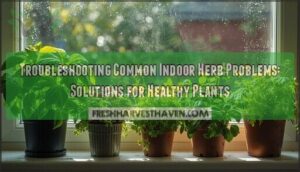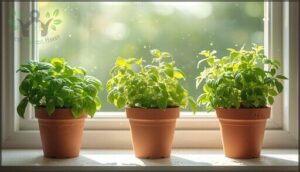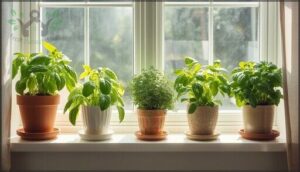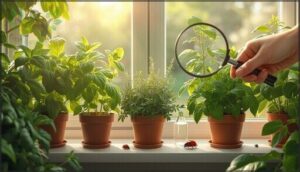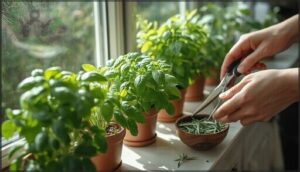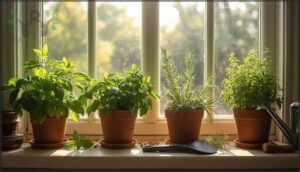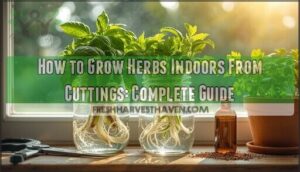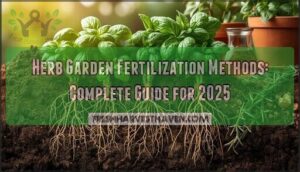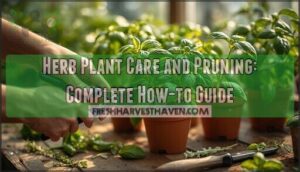This site is supported by our readers. We may earn a commission, at no cost to you, if you purchase through links.
A pot of healthy basil on the kitchen counter feels like a slice of summer—until its leaves start yellowing or drooping and you’re left wondering what went wrong. Indoor herbs don’t always speak up in ways you’d expect, but they communicate every struggle through color, texture, and growth patterns.
Catching these subtle signals early can make the difference between a thriving window garden and a row of stubborn, stunted pots. When you understand the clues—wilting leaves, spindly stems, unexpected pests—you gain the confidence to troubleshoot common indoor herb problems and nurture your plants through nearly any challenge.
Table Of Contents
- Key Takeaways
- Identifying Common Indoor Herb Problems
- Diagnosing Lighting Issues in Indoor Herbs
- Preventing Watering Mistakes
- Choosing Proper Containers and Drainage
- Solving Soil and Nutrition Problems
- Managing Humidity and Temperature Fluctuations
- Controlling Indoor Herb Pests
- Addressing Disease and Fungal Issues
- Pruning and Harvesting for Herb Health
- Troubleshooting Herb Problems by Species
- Frequently Asked Questions (FAQs)
- Conclusion
Key Takeaways
- Early signs like yellow leaves, drooping stems, and slow growth signal key problems with watering, light, or nutrition for indoor herbs.
- Herbs need consistent care—regular inspection, tailored watering, and pots with good drainage—to prevent issues like root rot, pests, and nutrient deficiencies.
- The right amount and type of light, including using south-facing windows or grow lights, directly impacts herb health, growth, and flavor.
- Tracking symptoms, adjusting care for each herb type, and quick action against pests or disease sets the foundation for a thriving, resilient indoor garden.
Identifying Common Indoor Herb Problems
Healthy herbs start with knowing what can go wrong before trouble really sets in. Spotting these problems early sets you up to fix them fast.
Knowing what can go wrong before it starts is the key to keeping your indoor herbs healthy and thriving
Here’s what to look for as you check on your indoor plants.
Recognizing Early Warning Signs
When growing herbs indoors, learn to trust what your plants show you. Leaf color changes—especially yellowing leaves or sudden brown spots—often hint at poor drainage or nutrient gaps. Notice wilting patterns or spindly growth? These warn of weak roots or not enough light.
Inspection frequency matters; regular checks reveal early foliage damage, pest issues, or root rot before trouble spirals. Before bringing new herbs indoors, examine them thoroughly for signs of insects.
Most Affected Herb Varieties
Certain herbs consistently appear at the top of the Common Herb Problems list. Basil problems often involve yellowing leaves or fungal outbreaks, while Mint vulnerability comes from pests and humid conditions. Rosemary challenges show up as slow, spindly growth if light is limited. Dill problems can develop with temperature swings, and Oregano sensitivities surface as stunted plants or pest issues when light and air fall short.
To avoid these issues, it’s important to provide adequate hours of sunlight for best growth.
How to Track and Document Issues
Once you recognize patterns in basil, mint, or rosemary struggles, your next step is tracking what you observe. Symptom logging—whether snapping photos with digital tools or jotting quick notes in a plant journal—adds clarity.
Data logging soil moisture or watering routines keeps details from slipping through the cracks, while documentation standards lay a solid foundation for confident, effective herb care and maintenance.
Diagnosing Lighting Issues in Indoor Herbs
Light can make or break an indoor herb garden, but it’s not always easy to tell when things are off. Sometimes, the signs are subtle and creep up before you notice.
Here’s what to watch for if you think your herbs mightn’t be getting enough light.
Symptoms of Insufficient Light
Noticed your indoor herb garden looking a bit off lately? Lack of light reveals itself in several ways, often hiding in plain sight:
- Leaf discoloration or pale, yellowing foliage
- Dramatic stem elongation as plants stretch for sunlight
- Reduced growth, with fewer new leaves appearing each week
- Abnormal leaves—smaller, narrower, sometimes curled or oddly shaped
These symptoms signal unmet lighting requirements, even when using grow lights.
Best Window Directions for Herbs
By positioning your indoor herb garden near a south-facing window, you tap into abundant sunlight, boosting yields and flavor. East-facing herbs enjoy gentler morning rays, reducing stress. West-facing windows offer warmth but risk scorched leaves by afternoon. North-facing solutions require creativity—few herbs thrive there without supplemental light.
Always consider seasonal variations, since each window’s performance changes throughout the year.
Using Grow Lights Effectively
Wondering if your indoor herb garden needs more than sunlight? Investing in LED grow lights ensures your lighting requirements are met, even on cloudy days.
Focus on light intensity—aim for 12 to 16 hours of full-spectrum daily duration. Strategic placement strategies, like keeping LEDs 12–14 inches above the canopy, boost efficiency.
With balanced spectrum and careful use, you’ll reduce lack of light issues fast.
Preventing Watering Mistakes
Regarding watering your herbs, a few common mistakes can sneak up on even the most careful indoor gardener. Knowing what to watch for and how to adjust your routine can make all the difference.
Let’s look at some practical ways to help your plants thrive.
Signs of Overwatering and Underwatering
Consider this: yellowing leaves with a limp texture can be a red flag for overwatering, often hinting at poor drainage or looming root rot. On the flip side, if your herb’s soil feels bone dry and the leaves turn brown and crisp, underwatering is likely at play. Monitoring leaf texture and growth rate reveals early trouble.
How to Test Soil Moisture
Curious if your watering habits hit the mark? Soil moisture isn’t mystery; it’s measurable. Slide in a calibrated meter for accuracy, or rely on tactile methods—the finger or chopstick test deliver solid results for most soil types, especially sandy mixes.
Try weighing pots for objective insights. Squeeze a handful; ideal ranges break apart gently, never dripping—drainage problems often lurk if they stick.
Creating a Consistent Watering Schedule
Think of a consistent watering schedule as the heartbeat of your herb garden—steady and reliable. Your success hinges on:
- Checking soil dryness before watering, preventing overwatering and drainage problems.
- Matching watering frequency to each herb’s needs.
- Adjusting schedules for seasons and pot size.
- Exploring automated systems for hands-off water management and fewer mistakes.
Choosing Proper Containers and Drainage
Picking the right pot plays a big role in your herbs’ health and growth. It’s not just about looks—drainage and materials matter, too.
Here’s what to think about as you choose the best home for your indoor herbs.
Importance of Drainage Holes
A pot without drainage is a gamble with your herbs’ future. Drainage holes prevent root rot, improve soil aeration, and support a balanced watering schedule—all fundamental for long-term plant health.
Without this outlet, water pools at the bottom, starving roots of oxygen, intensifying issues with poorly draining potting soil, and turning overwatering into a recipe for failure.
Pot Materials and Sizes for Herbs
Container material impacts more than aesthetics; terra cotta’s breathability quickens soil drying, while glazed ceramic and plastic retain moisture, suiting cilantro or chives.
Herb-specific sizing matters: basil, mint, and parsley need at least 6-inch containers for healthy roots. Match pot dimensions to the plant, and always pair with a well-draining potting mix for best container gardening results.
How Container Choice Impacts Root Health
Choosing the right container affects root health more than you might expect. Look for these key factors:
- Container depth ensures strong root systems.
- Fabric vs plastic pots—fabric encourages root branching and better oxygenation.
- Good drainage prevents root rot.
- Larger container size boosts plant growth.
- Avoid soil compaction; dense, poorly-draining potting soil limits root oxygen and stresses herbs in container gardening.
Solving Soil and Nutrition Problems
Getting your soil and plant nutrition right is the backbone of healthy indoor herbs. If your plants seem sluggish or their leaves aren’t looking their best, it may be time to review what’s in their pots.
Here are the key things to look for regarding soil and nutrients.
Selecting The Ideal Soil Mix
Soil quality supports healthy indoor herbs, so focus on a soil mix that balances organic matter for nutrition, the right soil texture for easy root growth, and drainage capacity to avoid waterlogging. Aim for a soil pH between 6.0 and 7.0.
Amending with perlite and compost improves soil nutrition but keeps poorly-draining potting soil from stunting your herbs.
Recognizing Nutrient Deficiencies
Noticing yellowed leaves, leaf spots, or stunted growth? These are classic deficiency symptomology signals—each hinting at underlying plant nutrition or soil nutrition issues. Different herbs reveal species variation: basil often shows interveinal chlorosis, mint becomes pale and brittle, while rosemary suffers tip burn.
Careful recognition methods—observing older versus younger leaves—help you pinpoint deficiency prevalence, causes, and the specific plant care and nutrition your herbs crave.
Fertilization Tips for Healthy Herbs
A well-nourished herb garden doesn’t happen by chance—it’s a dance of timing, restraint, and the right mix. Smart plant nutrition starts with biweekly, half-strength fertilizer for leafy herbs. Choose the best fertilizer type for your specific herb—woody varieties need less frequent feeding.
Focus on these top fundamentals:
- Adjust fertilizer frequency by herb type
- Begin feeding at proper plant height
- Avoid over-fertilization risk factors
Managing Humidity and Temperature Fluctuations
Humidity and temperature often shift more indoors than you might expect, and your herbs feel every bit of it. These changes can make plants struggle if you’re not prepared.
Let’s look at some practical ways to keep their growing environment steady.
Optimal Humidity Levels for Herbs
Think of your indoor herb garden like a living sponge—too little or too much water in the air spells trouble. Ideal humidity levels fall between 40% and 60%.
Regular humidity monitoring lets you catch excessive humidity or insufficient humidity early, both known for stunting growth.
Stable humidity keeps plants vigorous, minimizing stress. Prioritize humidity control for effective herb care.
Preventing Stress From Temperature Swings
With every degree swing, your indoor herb garden feels the impact—sometimes more than you’d expect. Shield your plants by:
- Practicing preventative placement—avoid drafty windows and heat vents.
- Creating consistent microclimates by grouping pots together.
- Using insulated containers for better root protection.
Ideal temperatures and intentional temperature control mean healthier, more resilient plants and tastier harvests year-round.
Tools to Monitor Indoor Conditions
If you want your indoor herbs to thrive, it pays to have the right tools. Digital thermometers and smart sensors help you track humidity and temperature control, while soil moisture meters make certain water never becomes a guessing game. Light meters measure sunlight levels, and mobile apps tie it all together—giving you instant insight into watering, soil mix, and your plants’ environment.
Controlling Indoor Herb Pests
Dealing with pests is a part of every indoor herb gardener’s journey. These small invaders can crop up even in the cleanest, healthiest setups.
Here’s what you need to know to spot, manage, and prevent common pest problems in your indoor garden.
Identifying Common Indoor Pests
Notice signs of sap-sucking pests: aphids cluster on soft growth, spider mites leave tiny webs, while whiteflies flutter up when touched. Mealybugs look like white cotton on stems. Early pest identification protects your indoor herb garden.
Infestation symptoms—yellowing, stunted growth, or sticky residue—signal it’s time to adjust your pest management and prevention tips for effective garden pest control.
Safe and Effective Pest Control Methods
If pests show up, don’t reach for harsh sprays. Start with physical removal—handpick or rinse pests away. Insecticidal Soap combats soft-bodied bugs, while Neem Oil interrupts pests’ life cycles. Biological Controls, such as predatory mites, are allies in your indoor garden.
Layer these pest control methods with IPM strategies for safe, reliable pest control and management.
Preventing Pest Infestations
Alongside smart pest control methods, weaving quarantine protocols, strict sanitation methods, and environmental controls into your routine forms a sturdy shield against sap-sucking pests.
Thorough monitoring techniques—like weekly leaf checks and sticky cards—help you catch problems early.
Careful, sanitary handling of new plants and soil cuts the risk of outbreaks, forging a strong foundation for lasting pest and disease management indoors.
Addressing Disease and Fungal Issues
Disease and fungal problems can creep up quietly, but a few warning signs usually show before things get out of hand. If your herbs are struggling, it’s often a matter of knowing what to look for and acting quickly.
Here’s what you need to know to keep your indoor plants healthy and strong.
Common Diseases in Indoor Herbs
Snags with indoor herb plant care often start with diseases lurking in the background. Fungal infections—including powdery mildew and rust disease—are leading hurdles for herbs kept indoors. Keep your eyes out for:
- White, powdery or orange leaf spots
- Soft, water-soaked stems (a warning for root rot)
- Sudden black or brown spotting from leaf spot pathogens
Strong disease prevention and smart plant care strategies make all the difference.
Signs of Root Rot and Fungal Infections
When root rot or fungal infections take hold, you’ll spot root discoloration—healthy roots turn brown or mushy, sometimes smelling musty. Foliar symptoms like yellowing, wilting, or browning leaves often show up first. Watch for gray fuzz or spots on stems.
Persistent dampness, poorly draining potting soil, and slow growth are reliable soil cues. Overwatering heightens these growth indicators and fungal signs.
Steps to Prevent Disease Spread
After spotting brown roots and musty smells, swift action matters. Practicing Sanitation Practices like using clean pots, removing plant debris, and isolating sick herbs quickly helps protect healthy neighbors. Tighten up Routine Monitoring—inspect weekly, prune with care, and don’t let water linger. Try these steps for better harvests:
- Thoroughly clean and disinfect containers between crops
- Isolate and observe new or ill plants two weeks
- Keep air flowing and avoid soggy soil
Pruning and Harvesting for Herb Health
Keeping your indoor herbs healthy isn’t just about watering or sunlight—it’s also about knowing when and how to trim and gather what you grow. Thoughtful pruning and timely harvesting will help your plants stay healthy and productive.
Here’s what you’ll want to keep in mind for your next round of care.
Proper Pruning Techniques
Think of pruning in your indoor herb garden as a regular tune-up—neglect it, and you’ll see leggy, weak plants. Pruning Frequency matters: every two to four weeks for most herbs.
Always use clean, sharp scissors for Tool Sanitation.
For best results, follow Herb-Specifics—like pinching basil above leaf pairs—and avoid common Pruning Mistakes that stress your plants.
Timing Harvests for Plant Vitality
When you time your harvests just right, flavor and regrowth take off. For many herb varieties, harvesting at prime stages—like full bloom for savory or before basil flowers—protects oil quality and boosts biomass.
Cutting several stems per week, rather than all at once, encourages steady herb growth and preserves plant vitality. Harvest Frequency shapes the course of your indoor harvests.
Removing Dead or Damaged Growth
Addressing dead or damaged leaves is central to effective Garden Maintenance. Pruning Techniques focus on cutting back to healthy tissue, removing the risk of disease. Regular Pruning Frequency—every two or three weeks—strengthens new growth and enhances flavor.
Sanitation Practices, like sterilizing tools, keep infections in check. Every well-timed removal shapes the Growth Impact, speeding healing and safeguarding Disease Prevention with thoughtful Harvesting and Pruning.
Troubleshooting Herb Problems by Species
Every herb has its own set of quirks, and sometimes a universal fix just doesn’t cut it. If you’ve struggled with basil, mint, rosemary, or dill, you’re not alone.
Let’s look at what each type needs when problems pop up.
Basil-Specific Issues and Solutions
Ever notice how basil’s leaves yellow, wilt, or spot overnight? Basil diseases can sweep through an Indoor Herb Garden with surprising speed. Here’s how to stay a step ahead:
- Monitor humidity—high levels foster downy mildew.
- Rotate for airflow, minimizing environmental stress.
- Test soil nutrition regularly for healthy growth.
- Embrace organic pest control for peace of mind.
Mint, Rosemary, and Dill Troubleshooting
Did you know that Mint mildew and aphids flourish when air circulation is poor or watering habits slip?
Rosemary browning often starts in soggy soil or dim corners—watch for needle drop, the first whisper of trouble.
Dill spacing matters, too; cramped roots and fading light stunt its growth. Spotting shared symptoms and species diseases early keeps your herb gardening tips practical and your plant care sharp.
Adjusting Care for Unique Herb Needs
Not every herb appreciates the same rhythm—basil thrives with steady warmth and consistent moisture, while thyme favors drier soil and less fuss over sunlight.
Getting Herb-Specific Lighting or fine-tuning Watering Uniqueness prevents common Indoor Herb Gardening Mistakes.
Blend Soil Customization and Nutrient Needs for each plant, and rethink Microclimate Creation for your crowd. Precision unlocks health.
Frequently Asked Questions (FAQs)
Can I grow herbs year-round indoors?
You absolutely can grow herbs indoors year-round with the right approach. Prioritize lighting requirements, humidity considerations, and a thoughtfully chosen soil mix.
Many indoor herb varieties thrive with proper winter herb care, offering fresh flavors and surprising economic herb growth.
How do I revive wilted indoor herbs?
Wilted indoor herbs aren’t auditioning for a dramatic exit—they’re just asking for immediate hydration, watering adjustments, gentle light correction, and soil management.
Remove damaged leaves and check for poorly-draining potting soil or poor water quality in your indoor herb gardening setup.
Are pet-friendly herbs safe to grow indoors?
Pet-friendly herbs are generally safe to grow indoors, but herb toxicity varies by species. Stick to safe varieties like basil and parsley.
Use garden barriers and maintain Houseplant Maintenance to prevent pet ingestion, and always seek veterinary advice if concerned.
Do indoor herbs need regular repotting?
Indoor herbs benefit from regular repotting every 1–2 years, as repotting frequency helps prevent root-bound signs, counters soil depletion, and encourages growth.
What causes herbs to lose their flavor indoors?
Herbs lose flavor indoors due to lack of light—particularly the right light spectrum—as well as suboptimal soil composition, inconsistent watering impact, temperature effects, and improper fertilization practices.
Following expert indoor herb gardening tips safeguards essential flavor compounds.
Conclusion
Like a careful detective in a garden of mysteries, you learn to read the silent language of your herbs—the droop of a stem, the pale patch on a leaf. Each clue guides you closer to mastering troubleshooting common indoor herb problems.
By responding to your plants’ subtle signals, you shift from reacting to anticipating, transforming problems into opportunities for growth. A steady hand and keen eye help your indoor garden remain both resilient and rewarding, season after season.
- https://farmingaide.com/indoor-herb-garden-problems/
- https://www.finegardening.com/project-guides/fruits-and-vegetables/the-dos-and-donts-of-growing-herbs-indoors
- https://www.livingetc.com/advice/indoor-herb-garden-mistakes
- https://ipm.cahnr.uconn.edu/herbs-greenhouse/
- https://hgic.clemson.edu/factsheet/houseplant-diseases-disorders/

